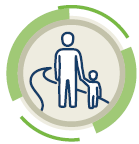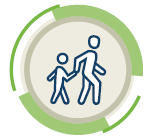Our objectives and priorities for walking
Our objectives for walking
Changes we want to see for walking in 10 years are detailed in our 5 objectives:
- more walking, more often
- our communities are planned to make walking enjoyable and convenient
- our streets and paths are welcoming, safe, connected and comfortable for all ages and abilities, and support vibrant local communities
- walking is an attractive and easy choice, particularly for short transport trips, tourism, recreation and health
- walking is a high priority in policy and planning, delivered through partnerships and supported by evidence.
More walking, more often
Knowing why and where people walk, their needs, desires and motivations can help us understand what we need to do to make walking an easy choice for everyone, every day.
Our communities are planned to make walking enjoyable and convenient
People are more likely to walk as part of their daily routines in communities that have connected street systems, interesting local places for people to walk to with comfortable and safe walking infrastructure.
Our streets and paths are welcoming, safe, connected and comfortable for all ages and abilities, and support vibrant local economies
Planning, designing and building comfortable, safe and accessible walking communities and transport networks for all, creates interesting, inclusive places that will also support vibrant local economies.
Walking is an irresistible and easy choice, particularly for short trips, tourism, recreation and health
Promoting the benefits of walking to the broader community through education, encouragement and behaviour change programs will encourage more people to walk, and help to make walking an irresistible, easy choice for short trips, tourism, recreation and health.
Walking is a high priority in policy and planning, delivered through partnerships and supported by evidence
Working together across all levels of government, with our partners in the community and private sector, we can ensure that walking is incorporated into all relevant plans and projects.
Our priorities for walking
We have identified 4 key priorities to encourage walking in Queensland. Each of these priorities includes key areas for action that will help us to achieve making walking an easy choice for everyone, every day:
- Planning walkable communities and places
- Building connected, comfortable and safe walking environments for all
- Encouraging more people to walk as part of their 'everyday'
- Working together to deliver for walking
 Planning walkable communities and places
Planning walkable communities and places
Footpaths and pathways are just one part of a quality walking environment. Many things contribute to making irresistible places to walk—a mix of close destinations to walk to, parks, open spaces, safety and surveillance, accessibility, places to stop and rest, and integration with public transport.
Queensland summers are hot and bring heavy rainfall in some areas, which means we also need to provide shade, shelter and water on walking routes.
Walkable environments support connected communities, providing places where people can meet, socialise and strengthen relationships.
We will plan walkable communities and places across 4 key action areas:
- Planning walkable communities—We will review urban planning and development processes and policies so that they are updated to give the necessary support for walking to be considered first.
- Planning walking precincts and connected networks—We will develop guidelines and support local governments to audit existing walking environments and to enhance their own walking networks.
- Integrating walking with public transport and other travel choices—We will focus on planning for peoples' whole journey experience from home to their destination by public transport – especially people with a disability.
- Designing facilities for all ages and abilities—We will review and improve design standards to ensure our walking networks and environments are safe, inclusive and accessible to everyone.
 Building connected, comfortable and safe walking environments for all
Building connected, comfortable and safe walking environments for all
Delivering networks that are accessible for people of all ages and abilities will result in more inclusive, active and healthy communities.
Queenslanders told us that providing more connected, smooth and even paths with shade and street trees along routes, greater separation from traffic, and lower traffic speeds in the right places will encourage them to walk more.18
We will improve walking infrastructure across 4 key action areas:
- Delivering connected and comfortable walking networks—We will work with local government to prioritise and implement improvements for walking in communities in the whole of Queensland.
- Making roads and precincts safer—We will work to improve pedestrian safety and convenience, lowering speed limits in targeted areas and designing shared paths with the needs of all users in mind.
- Revitalising local economies—We will trial temporary changes to streets to revitalise and strengthen our shopping precincts and local economy by making them stickier. Sticky streets are streets that entice people to stop, meet, linger and connect.
- Further developing our walking tracks and trails—We will continue to upgrade and maintain walking tracks in Queensland's national parks and forests, some with all-ability access encouraging people to get active and connect with nature.
18 Market Facts. 2019. Queensland Walking Survey, Survey Analysis Report Summary. Brisbane. Report prepared for the Department of Transport and Main Roads.
 Encouraging more people to walk as part of their 'everyday'
Encouraging more people to walk as part of their 'everyday'
Walking is fun, free and suitable for all ages and fitness levels. Walking for short trips can be an easy way to include physical activity into daily routines.
Yet raising awareness of these benefits is often not enough to create walking lifestyles across our communities and at different life stages.
How we travel or choose to spend our recreational time can become habitual. A short car trip to school or the shops becomes a routine that is unlikely to change without an encouraging nudge.
We will encourage more people to walk as part of their everyday across 4 key action areas:
- Developing a culture that supports walking—We will promote walking for health, transport and recreation and continue to deliver messages about safe behaviour on the road and provide education on road rules.
- Building and supporting walking habits for life—We will work with local government, community groups and industry professionals to encourage Queenslanders to walk more as part of their everyday routine.
- Building capability to deliver for walking—We will identify training needs and gaps reviewing existing training courses, and embed evidence-based, innovative approaches to increasing walking and creating walkable, inclusive environments.
- Managing and marketing tourism and recreational experiences—We will support Queenslanders to holiday in Queensland, continue to promote recreation trails to Queenslanders and tourists, and improve the information available about walks.
 Working together to deliver for walking
Working together to deliver for walking
To deliver walking environments that are attractive, enjoyable and accessible to everyone, we must prioritise walking in our policies, planning, operations and infrastructure.
Queensland's state government and its 77 local governments all play a role in creating walkable environments for people.
Our communities, the private sector and other stakeholders also need to be involved.
We will work together to deliver for walking across 3 key action areas:
- Work in partnership to prioritise walking in government policy—We will focus on the coordination between state and local government to deliver a better integrated transport network and encourage people to walk.
- Investing in walking—We will ensure funding programs are well-targeted and achieve value-for-money.
- Using evidence to guide decision-making about walking—We will work with local government to have a better understanding of walking by improving the way which we collect data. This will then support future decision making.
- Last updated 18 August 2019

